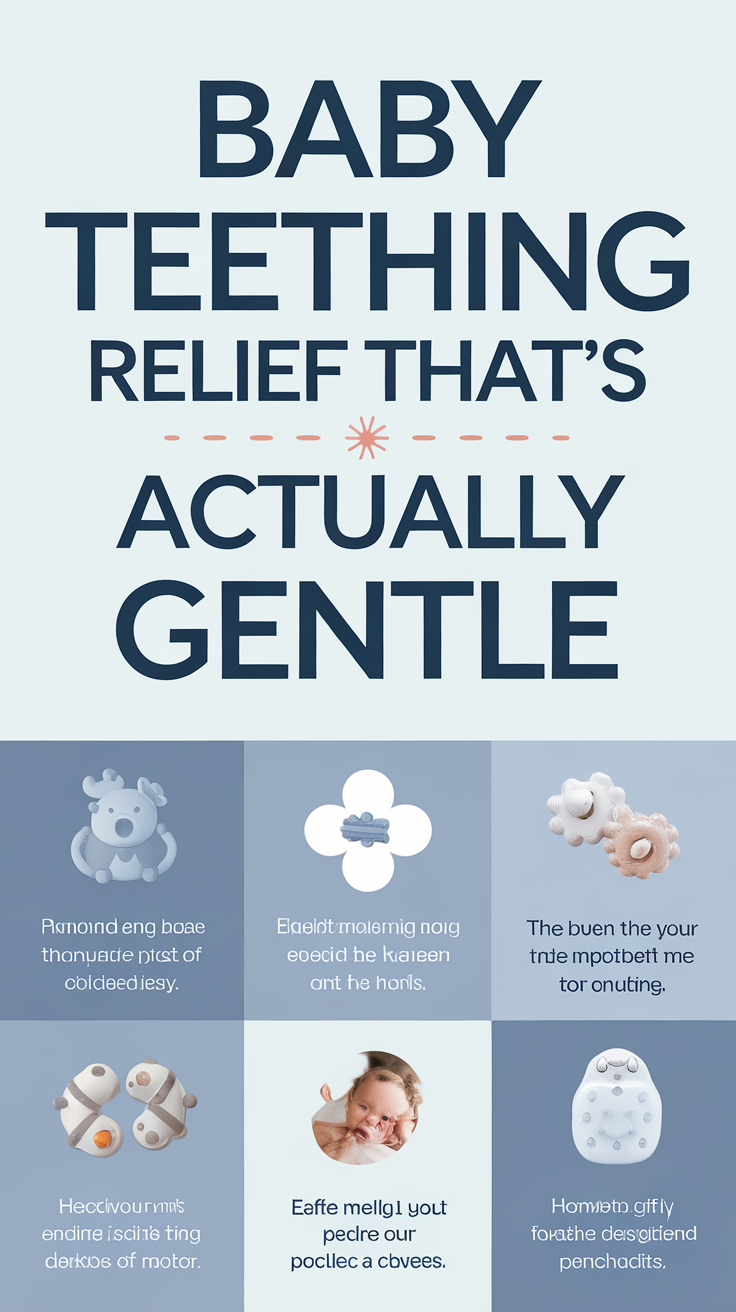Baby Teething Relief That’s Actually Gentle
When your baby’s teething, gentle relief is key. Look for natural teething toys made from organic materials that are safe and soothing. Soft finger massages on their gums can provide comfort, and warm compresses can relax tense muscles. Create a calming environment with soft music and dim lighting to ease their stress. It’s essential to monitor symptoms closely—if concerns arise, don’t hesitate to consult a pediatrician. Explore further to discover more effective ways to support your little one.
Key Takeaways
- Use natural teething toys made from organic materials to ensure safety and promote sensory exploration.
- Gently massage the baby’s gums with clean fingers or soft teething toys to provide comfort and distraction.
- Apply a warm compress to the baby’s cheeks for 5-10 minutes to relax muscles and alleviate discomfort.
- Create a calming environment with dim lighting, gentle music, and safe essential oils to soothe your baby.
- Trust your instincts; consult a pediatrician if symptoms worsen or if there’s a high fever or unusual irritations.
Understanding Teething in Babies
When your baby starts teething, it can be both an exciting and challenging time for you as a parent. Understanding the teething process is essential, as it helps you support your little one through discomfort.
Typically, teething begins around six months, though it can vary. Your baby may show increased drooling and fussiness, which are common signs of this developmental milestone.
To ease their discomfort, you can explore various teething baby remedies. Cold washcloths or teething rings can provide soothing relief, while gentle gum massages may help as well. Always choose safe, age-appropriate options.
Signs Your Baby Is Teething
As a parent, it’s important to recognize the signs that indicate your baby is teething.
You might notice common symptoms like increased drooling, irritability, or a desire to chew on objects.
Keeping an eye on these behavioral changes can help you provide the comfort your little one needs during this challenging time.
Common Teething Symptoms
Teething can be a challenging phase for both babies and parents, as it often comes with a range of noticeable symptoms.
You might notice your baby drooling more than usual, as increased saliva production is common during this time. They may also chew on toys or their fingers to relieve discomfort.
Pay attention to any signs of irritability or fussiness; your little one might be more sensitive than usual. Additionally, some babies develop a mild fever, although it shouldn’t exceed 100.4°F.
Changes in appetite can occur too, with your baby showing less interest in feeding. Finally, swollen gums may be visible when you gently check their mouth.
Recognizing these symptoms can help you provide the comfort they need.
Behavioral Changes to Watch
Noticing subtle shifts in your baby’s behavior can often signal that they’re teething. Look for signs that indicate discomfort or irritability, as these changes can help you identify when your little one is in need of relief.
Here’s a quick reference table of behavioral changes you might observe:
| Behavioral Change | Description |
|---|---|
| Increased fussiness | Your baby may cry more often. |
| Sleep disturbances | You might notice disrupted sleep. |
| Excessive drooling | A noticeable increase in drool. |
| Chewing on objects | They may gnaw on toys or fingers. |
| Loss of appetite | Your baby might eat less than usual. |
The Importance of Gentle Remedies
While your little one is going through the discomfort of teething, opting for gentle remedies can make a significant difference in their relief.
Harsh treatments or medications might seem tempting, but they can cause unwanted side effects. Gentle remedies, on the other hand, focus on soothing your baby’s pain without introducing harsh chemicals or overwhelming sensations.
These options not only promote comfort but also foster a positive experience during this challenging time. You’ll find that your baby responds better to gentle approaches, allowing them to feel more secure and calm.
Natural Teething Toys for Comfort
When it comes to soothing your teething baby, natural teething toys can be a great option.
Made from organic materials, these toys not only provide comfort but also guarantee safety for your little one.
Plus, their thoughtful design features cater specifically to the needs of infants, making them both effective and reassuring.
Organic Materials Benefits
Choosing natural teething toys made from organic materials can greatly enhance your baby’s comfort during the teething process. These toys are designed to soothe sore gums while ensuring your little one’s safety. Organic materials are free from harmful chemicals, providing a gentle option for your baby.
| Material | Benefits | Example Products |
|---|---|---|
| Organic Cotton | Soft, hypoallergenic | Cloth teething rings |
| Natural Rubber | Flexible, durable | Rubber teething toys |
| Bamboo Fiber | Antimicrobial, eco-friendly | Teething blankets |
| Maple Wood | Sturdy, chemical-free | Wooden teething beads |
Safe Design Features
Natural teething toys are designed with your baby’s safety and comfort in mind, incorporating features that minimize risks while maximizing relief.
Look for toys made from non-toxic, BPA-free materials to guarantee they’re safe for chewing. Many designs include soft edges and smooth surfaces to prevent any potential injuries.
Additionally, lightweight options make it easy for your little one to hold and manipulate, promoting independent exploration. Some toys even come with textured surfaces that soothe sore gums while encouraging sensory development.
Always check for small parts that could pose choking hazards. By choosing teething toys with these safe design features, you’re providing your baby with a gentle and effective way to cope with teething discomfort.
Soothing Gels and Ointments
As your baby experiences the discomfort of teething, soothing gels and ointments can provide much-needed relief. These products often contain gentle ingredients that numb the gums, helping to ease pain and irritation. However, it is crucial to choose carefully, as not all products are suitable for infants. Always consult your pediatrician before trying new remedies.
Here’s a quick comparison of some popular soothing gels and ointments:
| Product Name | Key Ingredients | Age Recommendation |
|---|---|---|
| Baby Orajel | Benzocaine | 2 months & older |
| Hyland’s Teething | Chamomilla | 6 months & older |
| Camilla | Natural plant extracts | 1 month & older |
| Little Remedies | Homeopathic ingredients | 3 months & older |
| Zymbears | Natural oils | 6 months & older |
Choosing the right product can make a significant difference in your baby’s comfort.
Herbal Teas to Soothe Discomfort
How can herbal teas provide comfort during your baby’s teething phase? Herbal teas like chamomile and peppermint can be soothing options.
Chamomile is known for its calming properties and may help reduce inflammation, making it easier for your little one to relax. Peppermint, on the other hand, has a mild numbing effect that can alleviate discomfort.
When preparing these teas, guarantee they’re caffeine-free and serve them lukewarm. Always consult with your pediatrician before introducing herbal remedies, as some herbs may not be suitable for infants.
You can also try herbal tea-infused water to keep your baby hydrated while offering gentle relief. Remember, every child is different, so pay attention to how your baby responds to these soothing options.
Cold Compress Techniques
Cold compress techniques can be an effective way to ease your baby’s teething discomfort.
You can use a clean, soft cloth dampened with cold water and place it in the refrigerator for about 30 minutes. Once it’s cool, gently apply it to your baby’s gums for a soothing effect.
Alternatively, you could use a small teething toy that you’ve chilled in the fridge. Just make certain it’s safe and free from any harmful materials.
The cold helps numb the pain while reducing swelling. Always supervise your baby during this process to guarantee they don’t accidentally bite down too hard.
These methods can provide targeted relief, making the teething experience more comfortable for both you and your little one.
Gentle Massage Techniques
When your baby is teething, gentle massage techniques can offer soothing relief.
You can use your fingers to massage their gums, incorporate soft teething toys, or apply a warm compress for added comfort.
These methods can help ease discomfort and promote a sense of calm during this challenging time.
Finger Massage Techniques
Many parents find that gentle finger massage techniques can provide significant relief for their teething babies.
Start by washing your hands thoroughly to guarantee cleanliness. Use your fingertips to apply gentle pressure on your baby’s gums, focusing on the areas where teeth are emerging. A circular motion can be soothing, and you can alternate between a light touch and slightly firmer pressure.
Pay attention to your baby’s reactions; if they seem to enjoy it, continue. You might also try massaging their cheeks and jawline, as this can help alleviate discomfort.
Remember to keep the session short and sweet, as your baby may not want prolonged contact. This simple technique can create a comforting bonding experience while easing their teething pain.
Using Soft Teething Toys
While teething can be a challenging time for both you and your baby, using soft teething toys can provide effective relief. These toys are designed to be gentle on your baby’s gums while still engaging their senses.
Look for textures that promote exploration and encourage your little one to gnaw, which can help ease discomfort. You can also gently massage your baby’s gums with the soft toy, allowing them to feel comforted.
Hold the toy for your baby, letting them chew at their own pace. This not only distracts them from the pain but also fosters their motor skills.
Warm Compress Application
As your baby navigates the teething process, incorporating warm compress applications can offer soothing relief.
Start by soaking a clean, soft cloth in warm water, wringing it out so it’s damp but not dripping. Gently apply the warm compress to your baby’s cheeks for about 5-10 minutes. This warmth can help relax tense muscles and alleviate discomfort.
You might also gently massage your baby’s gums with your clean fingers, using a circular motion. This not only provides relief but also comforts your little one during this challenging time.
Always make sure the compress isn’t too hot to avoid burns. Combining these techniques can create a calming routine that helps ease your baby’s teething woes.
Creating a Calming Environment
Creating a calming environment can considerably ease your baby’s discomfort during teething. Start by dimming the lights in your home; soft lighting can help create a soothing atmosphere.
Play gentle music or white noise to mask any jarring sounds that might disturb your baby. Consider using essential oils, like lavender, in a diffuser to promote relaxation, but make certain they’re safe for infants.
Keep the temperature comfortable, as a warm or overly cool room can add to your baby’s distress. Engage in quiet activities, like reading or cuddling, to provide comfort and distraction.
Finally, maintain a consistent routine, as predictability can help your baby feel secure during this challenging time. Your care and attentiveness will make a significant difference.
When to Consult a Pediatrician
When should you consult a pediatrician about your baby’s teething? It’s crucial to keep an eye on your baby’s symptoms. If you notice any of the following signs, reach out to your pediatrician for guidance:
| Symptom | Action |
|---|---|
| High fever (over 101°F) | Schedule a visit immediately |
| Diarrhea or vomiting | Contact your pediatrician |
| Rash or unusual irritation | Consult for advice |
| Persistent crying or discomfort | Discuss treatment options |
Teething can be uncomfortable, but extreme symptoms may indicate a different issue. Trust your instincts; if something feels off, don’t hesitate to seek professional help. Your pediatrician can provide reassurance and support tailored to your baby’s needs.


